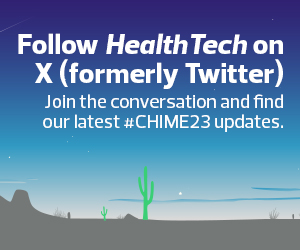Healthcare Organizations Value Strong IT Partnerships
Damian David, senior director of healthcare sales at Healthcare Triangle and moderator of the panel, called out that many people expect healthcare IT leaders to buy a “silver bullet.” However, the perception of what that solution is changes all the time, from digital experience solutions to population health. Today, that solution is generative AI.
David asked the panelists about the importance of the selection process and selecting technology that will work with foresight in mind.
“We try not to select a product, but a partnership and friendship,” Niles responded. He said that his team members are more like friends and business partners with their vendors, emphasizing the importance of trust.
At CalvertHealth, the leadership team discovered during the pandemic that their vendors weren’t able to support the organization in the way they were accustomed to, which Hall said caused her team to seek new partners.
“We made sure the partners understood that we were looking for a partnership and not a company to manage all these different things. We needed them to teach us how to fish,” she said, adding that it wasn’t a viable solution for the organization to pay management fees forever.
Healthcare Organizations Reduce Costs and Find Efficiencies
After layoffs that impacted Ozarks Healthcare’s IT department, Niles said the team’s workload increased, and they were left in a position where they needed to find ways to do more with less. A big focus for the team now is patient engagement. The organization is making it easier for patients to engage with the health system by redesigning its calling system. In addition, Niles’s team is consolidating different platforms using third-party software to realize cost savings.
He has been on the organization’s operations council for more than two years, which has led to fewer questions from stakeholders outside of IT.
“If I bring something up, they know it’s mission critical,” he said.
CalvertHealth just completed a project to consolidate its EMR across the entire organization. Hall said it had been a goal of hers since 2015.
“It is a really good thing for us, and I think it will be a good thing for patients, not only when it comes to safety, but they’ll have one portal to go through,” she explained.
The project involved centralizing billing from two separate groups. To make the project a success, CalvertHealth leadership worked to keep the scope small.
“It’s about trying to improve patient experience and engagement in a way that allows us to support the strategy, mission and vision of the organization,” said Hall. “We’re improving the quality of the care we deliver, and it’s exciting.”
In January the organization will be implementing a virtual nursing program. Hall is hoping that nurses will realize how technology can help and, as a result, become more open to expanding capabilities in the EMR.
READ MORE: Clinicians are the key to data-driven approaches to patient care.
Balancing New Technologies and Existing Investments Is Key
While optimizing existing technologies is an important aspect of creating cost efficiencies, health IT leaders are also considering new tools — including generative AI — that will reduce the burden on clinicians.
Hall pointed out that it’s difficult to hire nurses, leaving more work for the nursing team. If AI can write a note that makes sense, includes the correct information, isn’t duplicative and sounds like something a nurse wrote, then Hall said she’d take it.
“It’s really about whether we can build good tools that make it so that garbage going in doesn’t mean garbage out. If we can achieve that, then it’s a great thing,” said Hall. “In reality, the basis of healthcare and medicine doesn’t change, but the pieces on top of that change.”
Going forward CalvertHealth is focusing more on social determinants of health, DEI initiatives and making data more useful.
Niles said that Ozarks Healthcare is testing ambient listening technology. The health system is starting with a small pilot, hoping that clinicians will tell their colleagues, resulting in them approaching the IT team rather than the IT team forcing adoption of the technology.
Keep this page bookmarked for our ongoing coverage of CHIME23. Follow us on X (formerly Twitter) at @HealthTechMag and join the conversation at #CHIME23.













